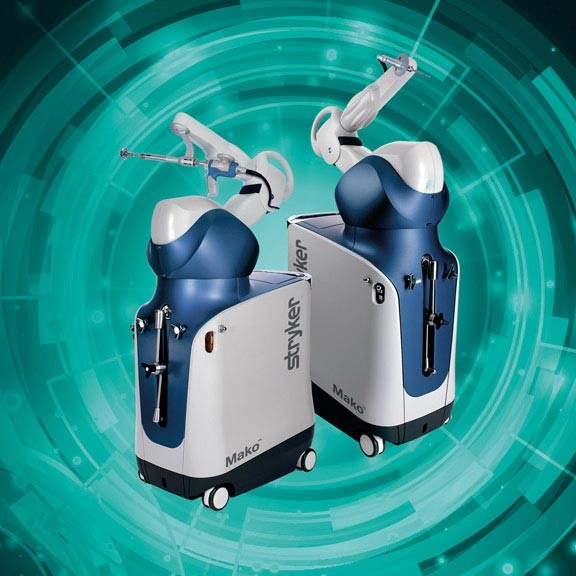Robotic orthopaedics
Robotic-arm assisted technology and 3D scanning for knee replacements or hip replacements.
The procedure
Orthopaedic surgeons at Spire Murrayfield Hospital can now use Mako’s robotic-arm to assist during total hip replacements and knee replacements. The robotic technology provides a personalised surgical plan for joint replacement surgery.
CT scans are used to create patient-specific, 3-D modelling for pre-surgical planning. In the operating room, your surgeon follows the personalised surgical plan while preparing the bone for the implant. The Mako robotic-arm guides your consultant within pre-defined areas which prevent them from moving outside planned areas, avoiding the removal of healthy bone tissue.
As surgeons use the robotic-arm to resurface the knee or hip joint for the placement of implants, the robotic-arm uses real-time, inter-operative feedback, enabling a high degree of precision and accuracy in placing implants. Research studies have shown that compared to traditional surgery, Mako can perform joint replacement with two to three times’ greater accuracy1
How Mako works
Based on preoperative CT scans, the Mako system generates a 3-D model of a patient's knee or hip joint.
This 3D model is used by the surgeons to determine how much bone to remove, and where to place the implants that replace diseased sections of these bones.
Without Mako, surgeons use a burr saw to remove bone. They work by eye and experience - instead of looking at the bone itself to determine whether enough has been removed. Mako tracks healthy and diseased bone with a LCD panel. Mako shows bone that needs to be removed as green; and areas of healthy tissue (which shouldn’t be removed) appear in red. This allows unparalleled accuracy within about two millimetres.
With Mako, the surgeon operates the robotic-arm that is equipped with a saw. The surgeon is free to remove bone until he reaches the boundaries prescribed during the planning stages. If the surgeon attempts to move outside these boundaries, the saw will turn off. This helps the surgeon minimise the trauma to the hip or knee and preserves the maximum amount of healthy tissue.
Movement during surgery
Unlike alternative robotic systems which clamp directly onto the bone, Mako is capable of tracking the position of the leg throughout surgery. This is achieved as it is not fixed relative to the bone but uses an infrared camera to track the position of the robotic-arm and the position of reflective bone screws placed in the bone. This is of crucial advantage to Mako patients as it leaves the surgeon free to move, adjust and test the musculoskeletal function of the hip or knee throughout surgery.
What the surgeons say

Consultant Orthopaedic Surgeon, Mr Jonathan Cowie
“The future of orthopaedic surgery is poised to change forever. Mako allows me to perform with consistent accuracy in bone preparation, implant placement, and balancing of soft tissue. This is the joint replacement I would recommend for my friends and family.”

Consultant Orthopaedic Surgeon, Mr Sam Patton
“These procedures are notoriously difficult to perform by hand. Mako makes this surgery more precise and reproducible. The best type of knee replacement is one that you forget that you have. Robotic surgery is a quantum leap in achieving this.”

Consultant Orthopaedic Surgeon, Mr Matt Moran
“This is cutting-edge technology for a more natural feeling joint and improved patient satisfaction after joint replacement.”
Book an appointment
If you’d like a consultation, call us on 0131 608 5682 . If you’re insured, call and advise your insurance company that you're arranging an appointment with one of our orthopaedic surgeons, as you’ll need an authorisation code to book your appointment.
Get in touch
1 Accuracy of UKA Implant Positioning and Early Clinical Outcomes in a RCT Comparing Robotic Assisted and Manual Surgery. Blyth MJ; Jones B; MacLean A; Anthony I; Rowe P;
13th Annual CAOS Meeting, June 12-15, 2013, Orlando, FL, USA.



